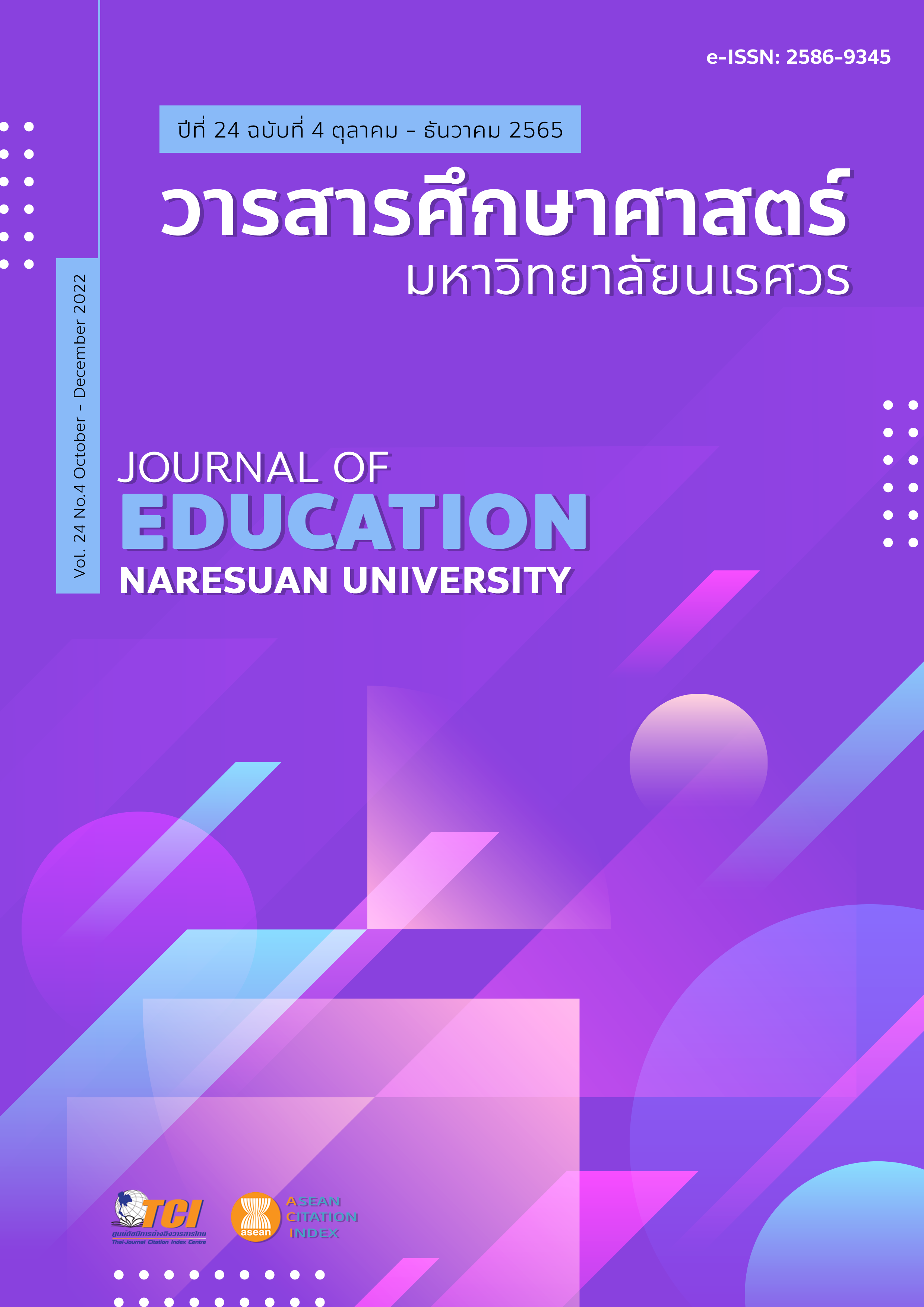อิทธิพลของการรับรู้ความสามารถของตนเองที่มีต่อผลสัมฤทธิ์ทางทหารของนักเรียนนายร้อยโดยมีความเพียรและสุขภาวะเป็นตัวแปรส่งผ่าน EFFECTS OF CADET SELF-EFFICACY ON CADET MILITARY ACHIEVEMENT OF CADET STUDENTS WHICH GRIT AND WELL-BEING AS MEDIATORS
Main Article Content
บทคัดย่อ
งานวิจัยครั้งนี้มีวัตถุประสงค์เพื่อ 1) ศึกษาระดับการรับรู้ความสามารถของตนเองความเพียร สุขภาวะ และผลสัมฤทธิ์ทางทหารของนักเรียนนายร้อย 2) ตรวจสอบโมเดลอิทธิพลของการรับรู้ความสามารถของตนเองที่มีต่อผลสัมฤทธิ์ทางทหารของนักเรียนนายร้อยโดยมีความเพียรและสุขภาวะเป็นตัวแปรส่งผ่านกับข้อมูลเชิงประจักษ์ และ 3) วิเคราะห์บทบาทการส่งผ่านของความเพียรและสุขภาวะในโมเดลอิทธิพลของการรับรู้ความสามารถของตนเองที่มีต่อผลสัมฤทธิ์ทางทหารของนักเรียนนายร้อย ตัวอย่างวิจัย คือ นักเรียนนายร้อยชั้นปีที่ 2-5 จำนวน 805 คน ได้มาโดยวิธีการสุ่มแบบแบ่งชั้น เครื่องมือที่ใช้เป็นมาตรวัดที่มีลักษณะเป็นมาตราส่วนประมาณค่า 6 ระดับ ได้แก่ มาตรวัดการรับรู้ความสามารถของตนเอง มาตรวัดความเพียร และมาตรวัดสุขภาวะ วิเคราะห์ข้อมูลโดยใช้การวิเคราะห์โมเดลสมการโครงสร้าง (SEM) ผลการวิจัย พบว่า 1) ในภาพรวมนักเรียนนายร้อยมีสุขภาวะอยู่ในระดับสูง (%RWB = 70.00) ในขณะที่ผลสัมฤทธิ์ทางทหารของนักเรียนนายร้อย ความเพียร และการรับรู้ความสามารถของตนเองอยู่ในระดับปานกลาง (%RCMA = 47.25; %RGRT = 44.00; %RSE = 35.00) 2) โมเดลอิทธิพลของการรับรู้ความสามารถของตนเองที่มีต่อผลสัมฤทธิ์ทางทหารของนักเรียนนายร้อยโดยมีความเพียรและสุขภาวะเป็นตัวแปรส่งผ่านมีความสอดคล้องกับข้อมูลเชิงประจักษ์ (Chi-Square = 44.620, df = 36, p-value = 0.131, Chi Square/df = 1.239, GFI = 0.991, AGFI = 0.978, NFI = 0.997; RMR = 0.015, RMSEA = 0.018) 3) การรับรู้ความสามารถของตนเองมีอิทธิพลทางตรงต่อผลสัมฤทธิ์ทางทหารของนักเรียนนายร้อย (β = 0.765, p < .05) ในขณะที่ความเพียรมีอิทธิพลทางลบต่อผลสัมฤทธิ์ทางทหารของนักเรียนนายร้อย (β = -0.704, p <. 05) อย่างไรก็ตาม สุขภาวะไม่ได้ส่งผลต่อผลสัมฤทธิ์ทางทหารของนักเรียนนายร้อยอย่างมีนัยสำคัญทางสถิติ
Article Details

อนุญาตภายใต้เงื่อนไข Creative Commons Attribution-NonCommercial-NoDerivatives 4.0 International License.
เจ้าของบทความมิได้คัดลอก หรือละเมิดลิขสิทธิ์ของผู้ใด หากเกิดการละเมิดลิขสิทธิ์ ไม่ว่าวิธีใด หรือการฟ้องร้องไม่ว่ากรณีใด ๆ ที่อาจเกิดขึ้นได้ กองบรรณาธิการวารสารศึกษาศาสตร์ ไม่มีส่วนเกี่ยวข้องทั้งสิ้น ให้เป็นสิทธิ์ของเจ้าของบทความที่จะดำเนินการ
เอกสารอ้างอิง
Bandura, A. (1977). Self-efficacy: Toward a unifying theory of behavioral change. Psychological Review, 84(2), 191-215.
Bandura, A. (1997). Self-efficacy: The exercise of control. New York: W H Freeman/Times Books/Henry Holt & Co.
Cadet Regiment King's Guard Chulachomklao Royal Military Academy. (2019). Manual of Cadet Student 2019. Bangkok: Aroonkarnpim. [in Thai]
Chulachomklao Royal Military Academy. (2015). Curriculum of Chulachomklao Royal Military Academy 2015 (5 years). Retrieved October 15, 2019, from http://www.crma.ac.th/edu/EDU.pdf [in Thai]
Cooper, A. (2014). Exploring the use of non-cognitive factors in predicting college academic outcomes (Master thesis). Chattanooga, TN: University of Tennessee.
Credé, M., Tynan, M. C., & Harms, P. D. (2017). Much ado about grit: A meta-analytic synthesis of the grit literature. Journal of Personality and Social Psychology, 113(3), 492-511.
Disabato, D. J., Goodman, F. R., & Kashdan, T. B. (2019). Is grit relevant to well-being and strengths? Evidence across the globe for separating perseverance of effort and consistency of interests. Journal of Personality, 87(2), 194-211.
Duckworth, A. L., Peterson, C., Matthews, M. D., & Kelly, D. R. (2007). Grit: Perseverance and passion for long-term goals. Journal of Personality and Social Psychology, 92(6), 1087–1101.
Duckworth, A. (2016). Grit: The power of passion and perseverance. New York: Scribner/Simon & Schuster.
Gilson, T. A., Dix, M. A., & Lochbaum, M. (2016). “Drive On”: The relationship between psychological variables and effective squad leadership. Military Psychology, 29(1), 58-67.
Hair, J. F., Black, W. C., Babin, B. J., & Anderson, R. E. (2014). Multivariate data analysis: Pearson new international edition (7th ed.). Harlow, Essex: Pearson.
Jiang, W., Jiang, J., Du, X., Gu, D., Sun, Y., & Zhang, Y. (2019). Striving and happiness: Between- and within-person-level associations among grit, needs satisfaction and subjective well-being. The Journal of Positive Psychology, 15(4), 543–555. https://doi.org/10.1080/17439760.2019.1639796
Oprins, E. A. P. B., Bosch, K. V. D., & Venrooij, W. (2018). Measuring adaptability demands of jobs and the adaptability of military and civilians. Military Psychology, 30(6), 576-589.
Phan, H. P., Ngu, B. H., & Alrashidi, O. (2016). Role of student well-being: A study using structural equation modeling. Psychological Reports, 119(1), 77-105.
Pekrun, R., Goetz, T., Frenzel, A. C., Barchfeld, P., & Perry, R. P. (2011). Measuring emotions in students’ learning and performance: The Achievement Emotions Questionnaire (AEQ). Contemporary Educational Psychology, 36(1), 36-48.
VandenBos, G. R. (2015). APA dictionary of psychology (2nd ed.). Washington, DC: American Psychological Association.
Vie, L., Scheier, L., Lester, P., & Seligman, M. (2016). Initial validation of the U.S. Army Global Assessment Tool. Military Psychology, 28(6), 468-487. DOI:10.1037/mil0000141


